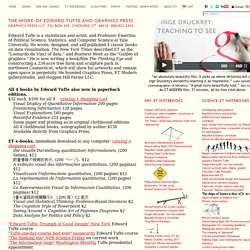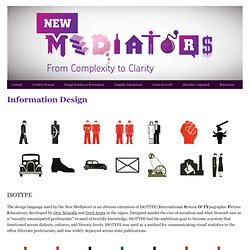

The Work of Edward Tufte and Graphics Press. Edward Tufte is a statistician and artist, and Professor Emeritus of Political Science, Statistics, and Computer Science at Yale University.

He wrote, designed, and self-published 4 classic books on data visualization. The New York Times described ET as the "Leonardo da Vinci of data," and Business Week as the "Galileo of graphics. " Information Design. The design language used by the New Mediators is an obvious extension of ISOTYPE (International System Of TYpographic Picture Education), developed by Otto Neurath and Gerd Arntz in the 1930s.

Designed amidst the rise of socialism and what Neurath saw as a “recently emancipated proletariate” in need of worldly knowledge, ISOTYPE had the ambitious goal to become a system that functioned across dialects, cultures, and literacy levels. ISOTYPE was used as a method for communicating visual statistics to the often illiterate proletariate, and was widely deployed across state publications. ISOTYPE is highly standardized, allowing slight alterations to distinguish points of data while they remain categorically comparable to each other. The addition of an gear symbol to a symbol representing man can specify mechanic. Similarly, a tie and briefcase can be added to connote business man. Stereotype This is powerful visual shorthand that communicates quickly. Related Work » Game Theory .net - Student's resources for learning game theory.
Game theory. Game theory is the study of strategic decision making.

Specifically, it is "the study of mathematical models of conflict and cooperation between intelligent rational decision-makers. "[1] An alternative term suggested "as a more descriptive name for the discipline" is interactive decision theory.[2] Game theory is mainly used in economics, political science, and psychology, as well as logic, computer science, and biology. The subject first addressed zero-sum games, such that one person's gains exactly equal net losses of the other participant or participants. Today, however, game theory applies to a wide range of behavioral relations, and has developed into an umbrella term for the logical side of decision science, including both humans and non-humans (e.g. computers, animals). Modern game theory began with the idea regarding the existence of mixed-strategy equilibria in two-person zero-sum games and its proof by John von Neumann.
Representation of games[edit] Extensive form[edit] Neuro-linguistic programming. Not to be confused with Natural language processing (also NLP) Neuro-linguistic programming (NLP) is an approach to communication, personal development, and psychotherapy created by Richard Bandler and John Grinder in California, United States in the 1970s.

Its creators claim a connection between the neurological processes ("neuro"), language ("linguistic") and behavioral patterns learned through experience ("programming") and that these can be changed to achieve specific goals in life.[1][2] Bandler and Grinder claim that the skills of exceptional people can be "modeled" using NLP methodology, then those skills can be acquired by anyone.[3][4][5][6][7] Bandler and Grinder also claim that NLP can treat problems such as phobias, depression, habit disorder, psychosomatic illnesses, myopia,[8] allergy, common cold,[9] and learning disorders, often in a single session.[10][11][12][13] NLP has been adopted by some hypnotherapists and in seminars marketed to business and government.[14][15]
Transformational grammar. In linguistics, a transformational grammar or transformational-generative grammar (TGG) is a generative grammar, especially of a natural language, that has been developed in the syntactic structures of phrase structure grammars (as opposed to dependency grammars).

Transformational grammar is the tradition of specific transformational grammars. Much current research in transformational grammar is inspired by Chomsky's Minimalist Program.[1] Deep structure and surface structure[edit] In 1957, Noam Chomsky published Syntactic Structures, in which he developed the idea that each sentence in a language has two levels of representation — a deep structure and a surface structure.[2][3] The deep structure represented the core semantic relations of a sentence, and was mapped on to the surface structure (which followed the phonological form of the sentence very closely) via transformations.
But the fundamental reason for [the] inadequacy of traditional grammars is a more technical one. Phrase structure grammar. The term phrase structure grammar was originally introduced by Noam Chomsky as the term for grammars as defined by phrase structure rules,[1] i.e. rewrite rules of the type studied previously by Emil Post and Axel Thue (see Post canonical systems).

Some authors, however, reserve the term for more restricted grammars in the Chomsky hierarchy: context-sensitive grammars, or context-free grammars. Methods of neuro-linguistic programming. The methods of neuro-linguistic programming are the specific techniques used to perform and teach Neuro-Linguistic Programming, a movement which teaches that people are only able to perceive a small part of the world using their conscious awareness, and that this view of the world is filtered by experience, beliefs, values, assumptions, and biological sensory systems.

NLP argues that people act and feel based on their perception of the world rather than the real world. Internal 'maps' of the world[edit] NLP calls each individual's perception of the world their 'map'. NLP teaches that our mind-body (neuro) and what we say (language) all interact together to form our perceptions of the world, or maps (programming). Each person's map of the world determines feelings and behavior.